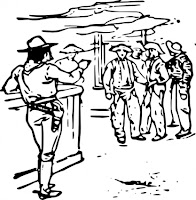There are many curriculum companies that advertise the absolute easiest in lesson presentation. And there is an appeal to the increasingly busy volunteer base that is consumed each week with work and school and extra-curricular activities. Who wouldn't want something that doesn't require extra time out of an already packed schedule?
But I fear the whole low/easy/no prep movement is missing some fundamental points. This isn't necessarily the fault of the curriculum companies, but rather the interpretation and expectation of the consumers. Let's take a look at these (warning: major ranting ahead!):
 1. Curriculum has always been easy to transfer and present. At the whopping age of 17, I was asked to teach a 5th grade Sunday School class. The kind lady in charge handed me a packet of curriculum from a major publisher. You know what was in it? Colorful posters to illustrate and enhance the lesson, handout materials so the kids can read and apply stuff through the week, worksheets to do with the kids, and a teacher's manual that presented the lesson word for word. If I had only been given this material fifteen minutes before class, I could have read the lesson out of the manual, pausing at the appropriately indicated times to show the poster or have the kids fill in the blanks. Easy prep is nothing new. Even today, most published curriculum lays out everything or even puts it all on a dvd, so all a teacher has to do is press "play."
1. Curriculum has always been easy to transfer and present. At the whopping age of 17, I was asked to teach a 5th grade Sunday School class. The kind lady in charge handed me a packet of curriculum from a major publisher. You know what was in it? Colorful posters to illustrate and enhance the lesson, handout materials so the kids can read and apply stuff through the week, worksheets to do with the kids, and a teacher's manual that presented the lesson word for word. If I had only been given this material fifteen minutes before class, I could have read the lesson out of the manual, pausing at the appropriately indicated times to show the poster or have the kids fill in the blanks. Easy prep is nothing new. Even today, most published curriculum lays out everything or even puts it all on a dvd, so all a teacher has to do is press "play."2. Somebody had to prepare the "low prep" curriculum. Somebody had to do the study and research in order to create the lesson plan and content. Some places even "field test" their curriculum in order to iron out the bugs. A lot of hard work goes into creating curriculum, because the message is important. And the fact that we are communicating this message to children makes it even more so.
And that leads us to the key missing point...
3. Low/easy/no prep curriculum requires prep! This may not be popular, but I believe that a volunteer who gets the teacher's book should open their manual, turn to the lesson, note the Scripture passage, close the manual, and spend some time in pure study of the passage before returning the teacher book. They should be thinking of how the lesson fits in the flow of the series, the individual needs of the kids in their class, and maybe even how to do the lesson better than the teacher's manual explains it. In short, the wise teacher needs to prepare, not just "look over" the lesson.
Now let the record show that I am not against "low prep" stuff in general. I'm sure most children's workers have had to "wing it" with the teacher's manual once in a while. Low prep curriculum can help simplify concepts and lay out creative strategies for presenting the lesson. Many outfits include video segments to help reinforce the lesson being taught. I'm all in favor of making volunteer's lives easier as much as possible.
But I have seen far too many volunteers say, "I love this curriculum, because I don't have to do anything to get ready for Sunday." I've watched the "teacher of the week" get his or her materials on Friday during lunch hour so they would be ready on Sunday. And I know a certain percentage of teachers look over the teacher's manual during commercials on Saturday night. It costs the teacher NOTHING and the kids get shortchanged. Most pastors I know (including my own) spend hours prayerfully laboring over the text and how to present it to their adult congregations. Yet the most important congregation of all gets the time it takes to read over the lesson manual on Saturday night (or in the car on Sunday morning!).
How much time is enough time for preparation? That may be the subject of another post, but for me, I ask myself, "if my low/easy/no prep curriculum got lost in a fire, could I still do the lesson on Sunday?" And maybe a more fundamental question is, "Are the kids worth what is most convenient to me or are they worth my very best?"
I'd love to hear your thoughts on this subject in the comments below.
Related post: Easy to Use and Transfer?
.

